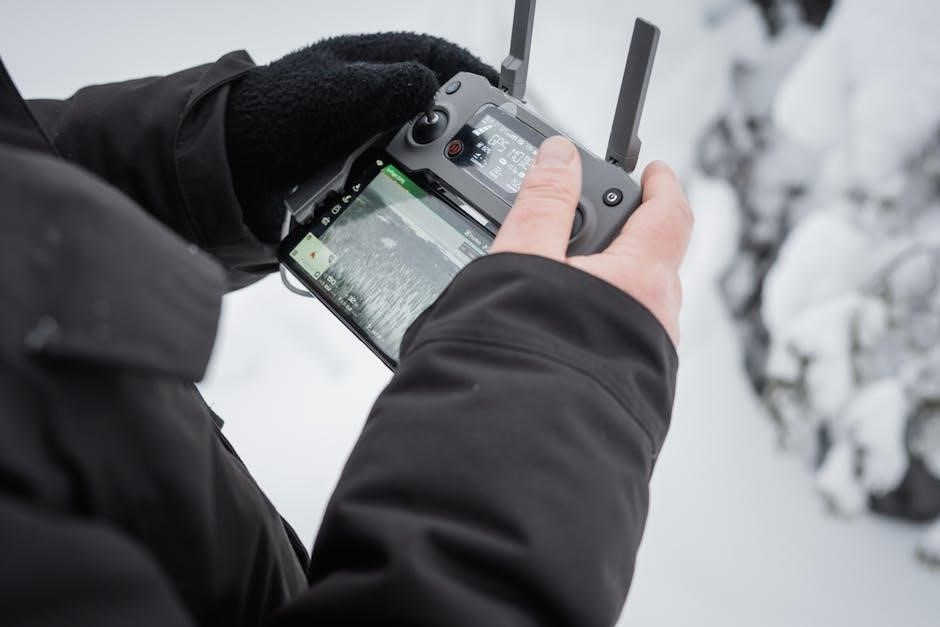The McGill Big 3‚ developed by Dr. Stuart McGill‚ is a foundational program targeting core stability and spinal health through three key exercises: Bird Dog‚ Side Plank‚ and Curl-Up.

Overview of the McGill Big 3 Program
The McGill Big 3 program‚ created by Dr. Stuart McGill‚ focuses on enhancing core stability and spinal health through three essential exercises: Bird Dog‚ Side Plank‚ and Curl-Up. These exercises are designed to strengthen the muscles that support the spine‚ improving posture and reducing back pain. Each exercise targets specific muscle groups‚ ensuring a balanced approach to core development. The program is simple yet effective‚ making it accessible for individuals at various fitness levels. By incorporating these exercises into a daily routine‚ individuals can build the foundation needed for long-term spinal health and stability. Consistency is key for optimal results.

Importance of Core Stability for Back Pain
Core stability is crucial for maintaining spinal health and reducing back pain. A strong‚ stable core provides the foundation for proper spinal alignment and movement. It helps absorb forces during daily activities‚ preventing excessive strain on the spine. Weak core muscles can lead to poor posture‚ muscle imbalances‚ and increased risk of injury. By enhancing core stability‚ individuals can better support their spine‚ reduce discomfort‚ and improve overall mobility. The McGill Big 3 exercises are specifically designed to target these stabilizing muscles‚ offering a proven approach to alleviate back pain and promote long-term spinal health. Consistent practice can lead to significant improvements in both strength and pain reduction.

The Bird Dog Exercise
The Bird Dog is a core-stabilizing exercise that strengthens the lower back and improves posture by engaging the latissimus dorsi and transverse abdominis muscles effectively.

Proper Form and Technique
Start on hands and knees in a tabletop position‚ ensuring a neutral spine. Engage your core and simultaneously extend your right arm and left leg‚ holding for 10 seconds. Avoid arching your back or using momentum. Focus on controlled movements and maintain stability throughout. Repeat on the opposite side. Keep your shoulders down and away from your ears‚ and ensure your hips remain level. Proper form is crucial to target the correct muscles and prevent strain. Practice slow‚ deliberate movements to maximize the exercise’s effectiveness and maintain spinal stability.
Common Mistakes to Avoid
When performing the Bird Dog‚ avoid arching your back or letting your hips sag‚ as this can strain your lower back. Ensure your shoulders remain down and away from your ears to prevent unnecessary tension. Many people lift their arm or leg too high‚ which can compromise form and effectiveness. Instead‚ focus on slow‚ controlled movements. Additionally‚ avoid holding your breath; maintain steady breathing to support core engagement. Letting the extended leg or arm droop mid-movement is another common mistake‚ as it disrupts stability. Finally‚ ensure your head stays in a neutral position to maintain proper spinal alignment throughout the exercise.
Muscles Targeted by the Bird Dog
The Bird Dog exercise primarily targets the erector spinae muscles in the lower back‚ which are crucial for spinal stability. It also engages the latissimus dorsi‚ glutes‚ and abdominal muscles‚ enhancing overall core strength. The exercise promotes proper motor control by activating the deep stabilizers‚ such as the transverse abdominis‚ ensuring a neutral spine position. Additionally‚ it strengthens the shoulder stabilizers‚ including the trapezius and rhomboids‚ which are essential for maintaining proper posture. By integrating these muscle groups‚ the Bird Dog helps improve balance‚ coordination‚ and spinal alignment‚ making it a cornerstone of the McGill Big 3 program for back pain management and core stability.

The Side Plank Exercise
The Side Plank is one of the McGill Big 3 exercises‚ focusing on lateral core stability by targeting the obliques and latissimus dorsi muscles to enhance spinal support and posture.
Step-by-Step Guide to Performing the Side Plank
Begin by lying on your side with your feet stacked and hands under your shoulders. Lift your hips off the ground‚ forming a straight line from head to heels. Engage your core‚ ensuring your weight rests on your forearm and the side of your foot. Avoid letting your hips sag or your shoulders collapse. Hold the position for 10 seconds‚ maintaining proper form. Breathe naturally‚ avoiding breath-holding. To modify‚ bend your knees slightly for reduced difficulty. Focus on stability and control throughout the exercise to maximize its effectiveness for core strength and spinal support.
Progressions and Modifications
Progressions for the McGill Big 3 can be achieved by increasing hold duration‚ adding dynamic movements‚ or incorporating light weights. For those with limited mobility‚ modifications include bending knees in the Side Plank or reducing the Curl-Up range of motion. Advanced individuals can extend holds or add resistance; Always prioritize proper form to avoid injury. Gradually progress to ensure stability and strength are maintained. Modifications are essential for accessibility‚ allowing individuals to benefit regardless of fitness level. Consistency and adherence to form are key to maximizing the program’s effectiveness for core stability and spinal health.
Role of the Side Plank in Core Stability
The Side Plank plays a crucial role in enhancing core stability by targeting the lateral musculature‚ including the obliques and quadratus lumborum. This exercise improves spinal alignment and strengthens the muscles essential for maintaining a neutral spine. By stabilizing the body on one side‚ it enhances proprioception and motor control‚ which are vital for preventing back pain. The Side Plank also promotes balanced muscle development‚ reducing the risk of unilateral weakness. Regular practice of this exercise contributes significantly to overall core resilience‚ making it a cornerstone of the McGill Big 3 program for individuals seeking to alleviate back pain and improve spinal health. Consistency is key to achieving optimal results.

The Curl-Up Exercise
The Curl-Up is a modified crunch targeting the abdominal muscles while protecting the spine. It emphasizes proper form to avoid strain‚ focusing on controlled movement and core engagement.
How to Perform the McGill Curl-Up
To perform the McGill Curl-Up‚ lie on your back with one leg straight and the other bent at a 90-degree angle. Place your hands under your lower back for support‚ ensuring your pelvis is in a neutral position. Engage your core muscles to maintain the natural curve of your spine. Slowly lift your shoulders off the ground‚ keeping your lower back pressed into the floor. Focus on using your abdominal muscles rather than your neck or shoulders. Hold for 10 seconds‚ then gradually lower back down. Aim for 10-15 repetitions on each side to ensure balance and symmetry.
Key Points for Maintaining Proper Form
Proper form in the McGill Curl-Up is essential for effectiveness and safety. Start by ensuring your pelvis is in a neutral position‚ with your lower back gently pressed into the floor. Avoid arching your back or using momentum. Engage your abdominal muscles to lift your shoulders‚ keeping the movement controlled and slow. Do not strain your neck or shoulders; the lift should come from your core. Maintain the natural curve of your spine throughout the exercise. Focus on quality over quantity‚ ensuring each repetition is performed with precision and stability. Proper form prevents injury and maximizes the exercise’s benefits for core strength and spinal stability.
Breathing Techniques During the Curl-Up
Proper breathing is crucial during the McGill Curl-Up to maintain core stability and prevent excessive intra-abdominal pressure. Begin by inhaling deeply before starting the movement‚ filling your lungs completely. As you lift your shoulders off the ground‚ exhale slowly and naturally‚ avoiding forced or held breaths. Coordinate your breath with the movement‚ ensuring a steady flow of air to support your core muscles. Avoid holding your breath‚ as this can increase pressure and strain. Instead‚ focus on a controlled exhale that matches the pace of your lift‚ helping to engage the transverse abdominis muscle effectively. Proper breathing enhances both safety and effectiveness during the exercise.

Benefits of the McGill Big 3 Program
The McGill Big 3 improves core stability‚ reduces back pain‚ prevents injuries‚ and enhances motor control‚ crucial for spinal health and fitness.
Improved Core Stability and Strength
The McGill Big 3 enhances core stability by strengthening the muscles that support the spine‚ including the abdominals‚ obliques‚ and latissimus dorsi. The Bird Dog targets the transverse abdominis‚ Side Plank engages the quadratus lumborum‚ and the Curl-Up activates the rectus abdominis. These exercises promote proper muscle activation patterns‚ improving posture and reducing strain on the lower back. By focusing on controlled movements and maintaining spinal neutrality‚ the program builds resilience against injuries and enhances overall core endurance. This foundation of strength and stability is essential for both athletic performance and daily activities‚ making it a cornerstone of spinal health and fitness.
Pain Reduction and Injury Prevention
The McGill Big 3 is renowned for its ability to reduce lower back pain and prevent injuries by strengthening the muscles that stabilize the spine. The Bird Dog‚ Side Plank‚ and Curl-Up exercises target key muscle groups‚ improving spinal alignment and reducing strain on the lower back. By addressing muscle imbalances and enhancing core stability‚ these exercises help alleviate chronic pain and minimize the risk of future injuries. Proper form is crucial to avoid exacerbating existing conditions‚ making these exercises a safe and effective solution for long-term spinal health. Consistency in practice ensures sustained pain relief and injury prevention.
Enhanced Motor Control and Coordination
The McGill Big 3 exercises excel at improving motor control and coordination‚ essential for optimal movement patterns. By engaging specific stabilizing muscles‚ these exercises teach the body to maintain proper spinal alignment during various activities. The Bird Dog enhances coordination between the upper and lower body‚ while the Side Plank and Curl-Up refine control over lateral and anterior-posterior stability. Better motor control reduces the risk of poor movement habits that can lead to injury. These exercises also promote neuromuscular efficiency‚ enabling smoother and more precise movements in daily life and physical activities. Over time‚ consistent practice enhances overall athleticism and functional mobility‚ making tasks easier and safer.

Incorporating the McGill Big 3 into Your Routine
Incorporate the McGill Big 3 into your routine with 10-15 repetitions of each exercise‚ held for 10 seconds daily. Consistency is key for spinal health.
Recommended Repetitions and Duration
Dr. McGill suggests performing each of the Big 3 exercises for 10-15 repetitions‚ holding each position for 10 seconds. This approach enhances core stability without overstraining. Consistency is key‚ and stopping if pain occurs is advised. Proper technique must be maintained throughout to maximize effectiveness and prevent injury. Regular practice helps build the foundational strength needed for spinal health. Over time‚ this routine supports long-term back pain reduction and improved motor control. It’s essential to balance each movement with the alternate side‚ as recommended‚ to ensure a well-rounded approach to core development.
Frequency and Consistency
Dr. McGill emphasizes that consistency is vital for the effectiveness of the Big 3 exercises. He recommends performing the exercises once daily‚ ideally at the same time each day‚ to establish a routine. Over time‚ this consistent practice helps build the necessary spinal stability and strength. It’s important to avoid overexertion and stop if any pain occurs. Regularity‚ rather than intensity‚ is key to achieving long-term benefits for back health. By incorporating these exercises into your daily schedule‚ you can gradually improve core stability and reduce the risk of back pain. Patience and dedication are essential for optimal results.
Warm-Up and Cool-Down Tips
A proper warm-up before performing the McGill Big 3 is essential to prepare the muscles and spine. Start with gentle movements like the cat-camel stretch‚ which involves arching and rounding the back in a kneeling position. Light cardio‚ such as brisk walking or cycling‚ can also be beneficial. After completing the exercises‚ cool down with static stretches‚ focusing on the hamstrings‚ hips‚ and lower back. Avoid bouncing or forced stretching‚ as this can strain the muscles. Dr. McGill recommends listening to your body and adjusting the intensity based on how you feel. Consistent warm-up and cool-down routines will enhance the effectiveness of the program and support long-term spinal health.

Additional Considerations
Nutrition‚ recovery‚ and a walking program complement the McGill Big 3. Dr. McGill emphasizes the importance of a balanced diet and regular walks to enhance spinal health and overall well-being.
Nutrition and Recovery
Nutrition plays a crucial role in supporting the effectiveness of the McGill Big 3 exercises. A balanced diet rich in proteins‚ healthy fats‚ and complex carbohydrates helps fuel workouts and aids in muscle recovery. Proper hydration is essential for maintaining spinal health and overall physical function. Additionally‚ adequate sleep and rest are vital for recovery‚ as they allow the body to repair and strengthen core muscles. Dr. McGill emphasizes the importance of combining these elements with the Big 3 exercises to optimize spinal stability and reduce back pain. A well-nourished body is better equipped to handle the demands of the program and achieve long-term benefits.
Walking Program as a Supplement
Dr. Stuart McGill recommends incorporating a walking program to complement the Big 3 exercises. Walking enhances spinal health by improving circulation‚ reducing stiffness‚ and promoting overall mobility. Start with short‚ brisk walks of 5-10 minutes‚ gradually increasing duration and intensity. This activity helps maintain spinal stability and supports the effectiveness of the core exercises. Regular walking also prevents sedentary behavior‚ which can exacerbate back pain. By combining the Big 3 with consistent walking‚ individuals can achieve better spinal health and reduce discomfort. This holistic approach aligns with McGill’s emphasis on integrating movement and strength for long-term back pain management.
Dr. McGill’s Other Recommendations
Beyond the Big 3‚ Dr. Stuart McGill emphasizes the importance of a balanced approach to exercises‚ ensuring equal repetitions on both sides to maintain symmetry. He also advocates for consistency‚ as regular practice yields the best results for spinal health. McGill recommends avoiding exercises that cause pain and focusing on proper technique to prevent injury. Additionally‚ he suggests coupling the Big 3 with a walking program to enhance spinal mobility and overall well-being. By following these guidelines‚ individuals can optimize their core stability and reduce back pain effectively.
The McGill Big 3 offers a proven approach to enhancing core stability and alleviating back pain through consistent practice and proper technique‚ fostering long-term spinal health.
Final Thoughts on the McGill Big 3
The McGill Big 3 is a scientifically-backed program that has transformed the approach to core stability and back pain management. By focusing on Bird Dog‚ Side Plank‚ and Curl-Up exercises‚ individuals can build resilience and reduce discomfort. Proper form and consistency are key to maximizing benefits. Dr. McGill emphasizes the importance of supplementing these exercises with walking and nutrition for optimal results. The program is not a quick fix but a long-term commitment to spinal health. Its simplicity and effectiveness make it accessible to everyone‚ ensuring sustainable progress in core strength and pain reduction over time.
Encouragement for Long-Term Consistency
Consistency is the cornerstone of success with the McGill Big 3 program. It’s essential to embrace these exercises as a long-term commitment rather than a quick fix; Celebrate small milestones‚ like mastering proper form or increasing hold duration‚ to stay motivated. Remember‚ spinal health is a journey‚ and patience is key. By incorporating the Big 3 into your daily routine and pairing them with Dr. McGill’s recommendations‚ such as walking and proper nutrition‚ you’ll build a strong foundation for a pain-free life. Stay dedicated‚ and over time‚ you’ll notice significant improvements in core stability‚ posture‚ and overall well-being.










